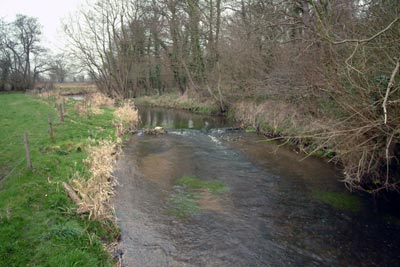 |
|
Probable
mill site 28th March 2003
|
|
Calthorpe Mill
River Bure |
 |
|
Probable
mill site 28th March 2003
|
|
Calthorpe had
two mills recorded in Domesday, whereas adjacent Erpingham
had none. However, no mention has been found of the Calthorpe mills from
then until 1249 when The Great Hospital of Norwich records show that the
founder of the hospital, Walter de Suffield, also owned the Rectory of
Calthorpe and all its lands. The second mill at Calthorpe would have disappeared
very early on as there was insufficient water to support both. |
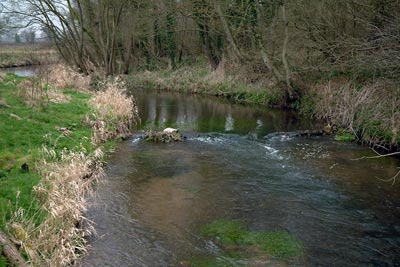 |
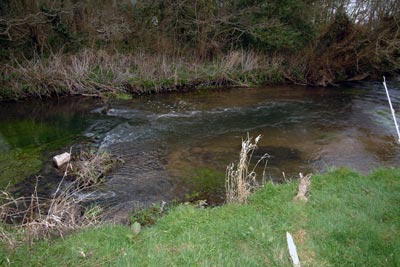 |
|
Millpond 28th March 2004
|
Wheelrace 28th March 2004 |
|
The Hospital of St. Giles, Norwich, founded by Walter de Suffield, alias de Calthorpe, in 1249, and now known as The Great Hospital, possessed a number of Manors, Rectories and lands etc. in Norfolk. These included the Rectory of Calthorpe, some four miles from Aylsham, consisting of houses, lands, barns and the watermill there, as well as rights connected with Calthorpe church. The first Master of the Hospital, incidentally, was the founder's brother, Sir Hamon de Calthorpe. The Bailiff's accounts for the rectory extend from 1323 to 1527 and there are many items of interest such as repairs to buildings and implements, working practices, names of people and places, details of livestock and crops grown. It is noticeable that the compiler of the 1385 account is less familiar with Latin than normally and there are several interesting examples of the English of the time, e.g. quales - wheels; skeppes; hyrdeles; carthows; mukhoc - muck hook; and schepone - shippon (cow-house). Also, numerous details are given in the accounts of the watermill - rents received, repairs and a variety of information creating a picture of its complete history until final disrepair and ruin overtake it in 1453. Today there is little evidence of the mill, other than the vestiges of a leat leading off the River Bure, and the remains of a pool overgrown with hassock-sedge. At this point, the Weavers Way footpath now traverses the river over a fine new wooden bridge, and the scenery here, and beyond en route for the Saracen's Head public house, with distant views of Wolterton Hall, is very pleasant indeed. At Domesday, it appears there were two mills at Calthorpe, the whole of one and a share of the other belonging to St, Benet's Abbey. At this time, it seems that there was one mill respectively at Blickling, Ingworth and Wickmere, but none at Erpingham. The account for 1323 deals with one of the two Calthorpe mills, and this was leased out for 40 shillings. Nails for repairs cost 1½d, and work to the mill pool 5¾d. In this account, also, there is a mention of the mill at Wickmere, when marl was spread upon the land there, and with half a rood at Holdegate, the total cost was 5/-. In 1329, the mill rent had increased to 50/-, paid by one Becker. Various repairs were carried out including roofing, thatching and ridging and purchase of a pair of trendles (trundle wheels) costing 9d; the whole totalling 3/3d. Flags (turves) were bought for 6d. for 'damyng' in 1382, and also one 'werdam' at the 'bayel' cost 12d. - a bayel was a reserve pond for storage of water to drive the mill. Men were hired in 1393, with their small boats, for cleaning 'le milledam' this year 46/8d. The millpond was also 'cleansed by dydaeres' this year - presumably men wielding dydles. It was an expensive year with many repairs necessary. 'Rygaldbordes' (planks from Riga in the Baltic) were bought, 6/8d., but three others cost nothing 'because taken from stock'. Oak wood was bought for 'millestertes' (supporting timbers, for the waterwheel) for 8d. Wages for men and a cart making a 'werdam' at the mill cost 2/-; and for making 'another werdam there' 8d. Expenses incurred with regard to the purchase of timber at Foxlee (Foxley) came to 10d. Various carts used for carriage of timber from Foxlee to Calthorpe cost 13/2. Timber bought for the Master at Norwich, for repair of the mill, cost 8d. Two years later, in 1395, sixpence had to be paid to Blickling mill, further upriver, for easement of the water that year. A man was paid 8d. for cutting turves from the common for the mill pool, and amongst many other costs and repairs, a 'corbel' was made for the mill stone, and this, with the making of 'le waterdre', cost 18d. Timber for the same, cost 20d. Expenses of various carts carrying timber from Hethill (Hethel), another of the Hospital's Manors, to Calthorpe Mill amounted to 5/3d. In 1445 the mill was leased for 16/8d - 'with a certain meadow annexed to the mill, to John Multon, miller, for the term of 13 years, this year the 9th.' And he had to maintain and repair the said mill. Six years later, Richard Palmer was paying 13/4d for the farm of the watermill, with a certain meadow, and he also had to maintain and repair the mill. Towards the end of 1453, the mill finally collapsed, Richard Palmer paying only one quarter's rent of 3/4d. Then, in the following account (1454/55) the reason for the mill's demise is clearly stated, namely that Richard Palmer neglected the upkeep of the mill. There was, therefore, no sudden catastrophe, and no indication of fire or flood. The entry states:- ".. the said mill collapsed to the ground on account of disputed repair of the same with respect to possession" No subsequent mill rent was received, so it seems that no attempt was made to rebuild. Several later accounts explain the absence of this, with a reference to the mill being ruined - 'devastat'. In 1474, Robert Stacy was paying 4/- for 'the farm (rent) of one meadow adjacent to the said mill, called le mylleker (mill carr)'. By 1512, a later tenant Walter Medylton, occupied this land, still at a rent of 4/- for 'the farm of one meadow, with one alder carr containing 5 acres, the same next the site of the mill in Calthorpe.' In 1526/27, mention is made of the aldercarr called 'milleker', although no rent is due, 'because the underwood is for the lord's use when eventually cut'. When the mill at Calthorpe fell into disrepair, a watermill and windmill may well have been operating at the time at nearby Erpingham, both of which were still there in 1885, and a windmill probably still stood at Calthorpe. The 1389 Bailiff's accounts show underwood being sold at 'Whenemyllehill' (windmill hill). The entry is crossed through, and 'Lytelwode' substituted. In 1395, mention is made of seed sown on 2 acres next 'Blowemyllehill' - again Windmill hill. In addition, there would doubtless have been competition from the mills close by at Blickling, Ingworth and Wickmere the foremost being a particular threat, as it could control the water coming down the Bure to Calthorpe. Contention with these others may well have also contributed to the eventual demise of the Hospital's watermill at Calthorpe. The second Calthorpe watermill, recorded in Domesday, probably ceased to exist early on. No evidence has come to light so far, as to its whereabouts. It seems unlikely that there would have been two, in quite close proximity on the river, and Scarrow Beck appears to be the most likely location. (Note: The Great Hospital documents relating to Calthorpe are at the
Norfolk Record Office (NRO) - Ref. Nch. Cty. Handlist, Press G |
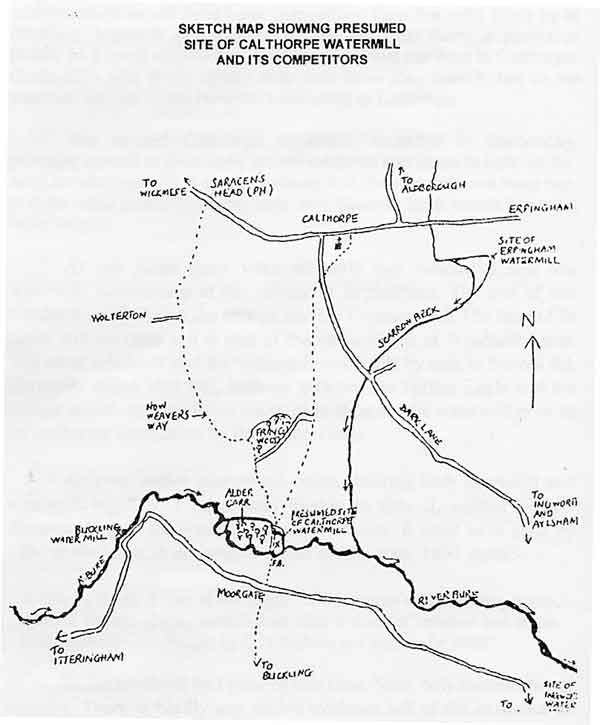 |
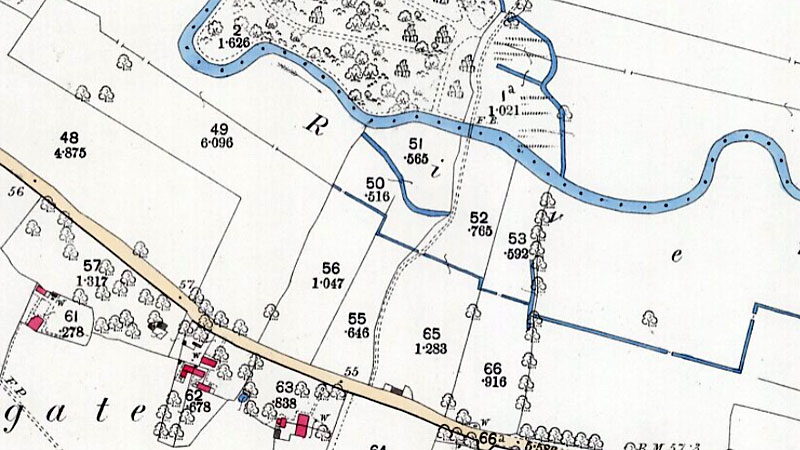 |
O. S. Map 1885 |
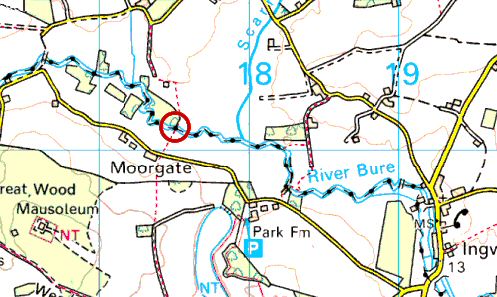 |
|
O.S. Map 2005 Image reproduced under licence from Ordnance Survey |
| 1249: Mill mentioned
in Great Hospital accounts 1385: First mention of the mill in the rectory accounts 1393: Men in small boats cleaned the mill dam for 46/8d and the millpond was also cleared by hand. Various amounts of timber were purchased to repair the mill. 1395: Blickling Mill was paid 6d for water easement. Various other repairs carried out 1445: John Multon, miller took over a 13 year lease for 16/8d, 1445 being the 9th year 1451: Richard Palmer leased the mill for 13/4d 1453: Towards the end of the year .. the said mill collapsed to the ground on account of disputed repair of the same with respect to possession. It appears Richard Palmer failed to maintain the mill |
If you have any memories, anecdotes or photos please let us know and we may be able to use them to update the site. By all means telephone 07836 675369 or
|
| Nat Grid Ref TG17513015 | Copyright © Jonathan Neville 2004 |